
1. e4 Nf6 2. e5 Nd5 3. Nc3 e6 4. Nxd5 exd5 5. Qf3

Theory now gives the pedestrian 5...c6. Yet it may seem unjust for Black to be relegated to this move, given that his development has been no less rapid than White's. Indeed, Black has available a dynamic alternative.
5...Nc6
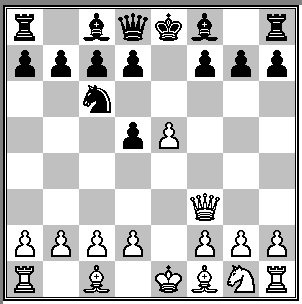
After the continuation 6. Qxd5 Nb4,
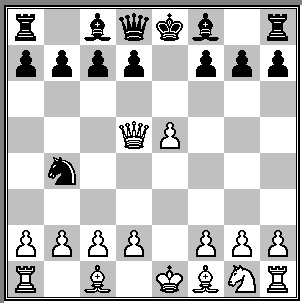
White has three retreats that keep the c2 square protected:
A. 7. Qb3
B. 7. Qc4
C. 7. Qe4
A. 7. Qb3

7...Qh4
The threat is now 8...Qe4+, not only to regain the pawn but also to force the White king to protect the c2 square. Various tries by White to keep the extra pawn:
A1. 8. Nf3
A2. 8. d3
A3. 8. c3
A1. 8. Nf3
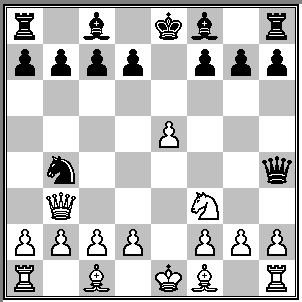
8...Qe4+ 9. Kd1 Qg6
Inhibiting the development of the f1-bishop, while sidestepping White's threat of 10. Qxf7+ Kxf7 11. Ng5+. The displacement of White's king gives Black compensation for the pawn.
A2. 8. d3
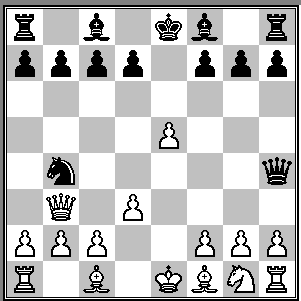
8...Bc5 9. Nh3
9. g3 Qd4 regains the pawn, as 10. Be3 Qxe5 11. d4 is met by 11...Qe4.
9...d5 10. g3
The threat was 10...Bxh3 followed by taking on f2. After 10. Bg5 Qh5, the capture of White's knight threatens to unhinge White's game at g5 and f3.
10...Qd4 11. Be3 Qxe5
Black seems to have no problems.
A3. 8. c3
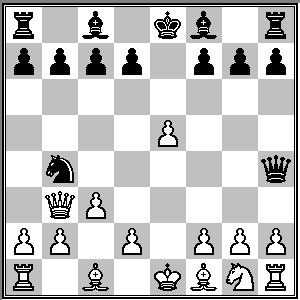
8...Qe4+ 9. Kd1 Nd3 10. Nh3
10. Bxd3 loses to 10...Qxg2.
10...Nxe5
10...Qe1+ 11. Kc2 Nxe5 12. d4 Nc6 13. Bg5 gains valuable time, as 13...Qxa1 loses to 14. Bc4 threatening mate and the queen. Black could vary by 12...Qe4+ (intending to transpose to the text line after 13. Ke1), but the text move is more straightforward.
11. d4 Nc6 12. Bc4 Qxg2 13. Bxf7+ Kd8 14. Re1 Be7 15. Nf4 Qg4+
A really mixed up position in which Black seems not to be at a disadvantage.
B. 7. Qc4

7...d5
White now has no appealing choices:
B1. 8. exd6 Bxd6 gives Black a significant lead in development. The attempt to force the closure of the e-file by 9. Qe4+ Be6 10. Bc4 O-O 11. Bxe6 (hoping for 11...fxe6) fails to 11...Re8 and ...Rxe6.
B2. 8. Qb3 Qh4 gives Black an extra tempo over Variation A.
B3. 8. Qc3 d4 9. Qb3 Be6 10. Qa4+ (10. Bc4 Bxc4 11. Qxc4 d3 12. cxd3 Qxd3 13. Qxd3 Nxd3+ and 14...Nxe5) 10...c6 (threatening 11...b5) 11. c3 b5 12. Qd1 Nxa2 regains the pawn, with ...Nxc1 in reserve.
C. 7. Qe4
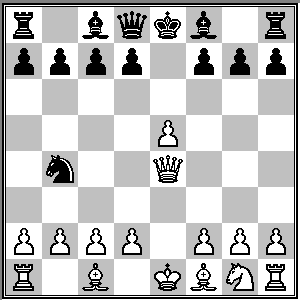
7...Qe7
Threatening 8...d5.
8. Bd3
White's queen would be lost after 8. a3 d5 9. Qxb4 Qxe5+.
8...d5 9. exd6 Qxe4+ 10. Bxe4 f5 11. a3
11. d7+ Bxd7 12. Bxb7 loses material to 12...Rb8. On 11. Bd3 Nxd3+ 12. cxd3 Bxd6, White's extra d-pawn is not much of an asset.
11...fxe4 12. axb4 Bxd6
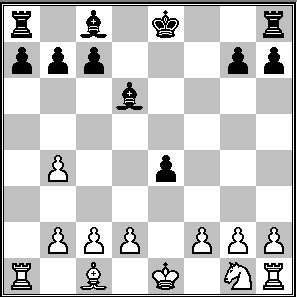
Realizing the pawn plus will be difficult for White, with vulnerable pawns at b4, d2 and f2, not to mention Black's two bishops. A possible continuation: 13. Ne2 Bf5 (13...Bxb4 14. Ng3 O-O 15. c3 [15. Nxe4 Rfe8 16. f3 Bf5 regains the pawn] followed by Nxe4) 14. Nd4 (14. Ng3 Bg6 15. c3 O-O 16. O-O a6 leaves Black in control of the d3-square) 14...Bd7 15. c3 O-O 16. O-O Be5 (White threatened 17. d3 exd3 18. Rd1) 17. Nb3 b6 (17...Bb5 18. Re1 Bd3 19. Nc5) 18. Re1 Rfe8 (preventing 19. Rxe4 due to 19...Bxh2+. 18...Bc6 would allow 19. d4, due to the pin) 19. d3 exd3 20. Be3, and a draw seems likely.